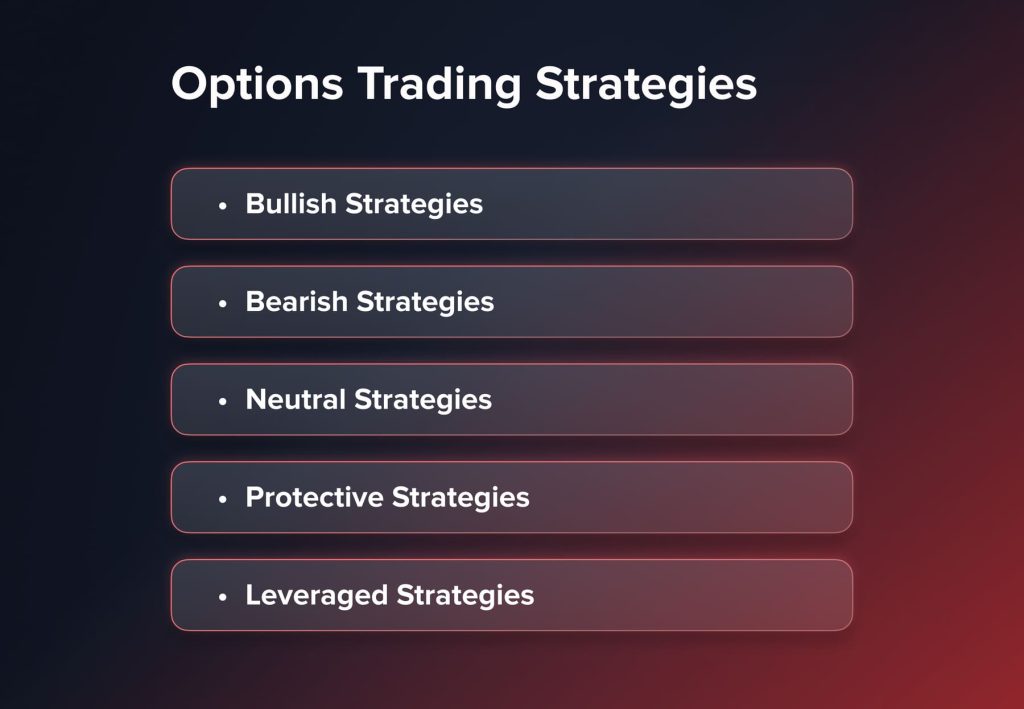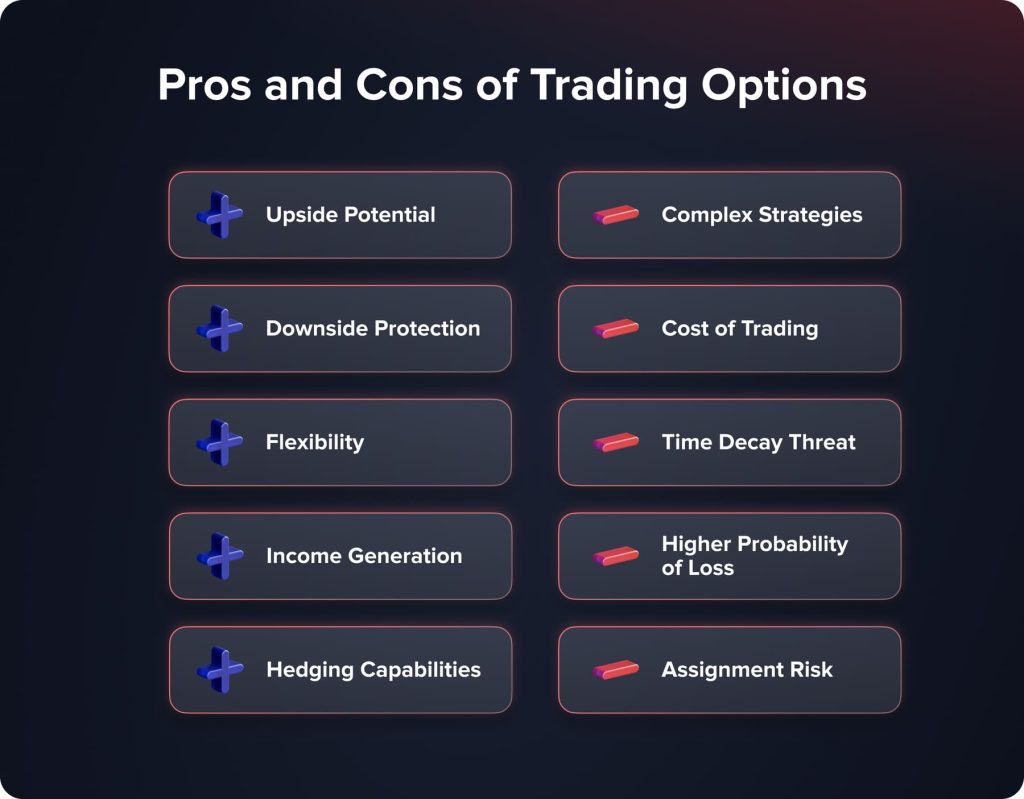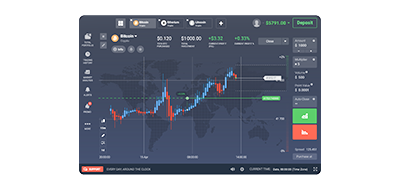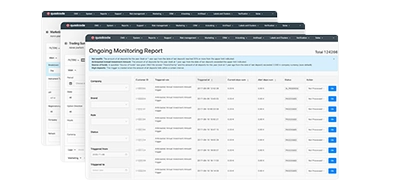Quay lại
Contents
Giao dịch quyền chọn là gì và nó hoạt động như thế nào?

Demetris Makrides
Senior Business Development Manager

Vitaly Makarenko
Chief Commercial Officer
Giao dịch quyền chọn là gì?
Giao dịch quyền chọn cho phép nhà đầu tư đầu cơ vào hiệu suất tương lai của các tài sản cơ sở như cổ phiếu, chỉ số, hàng hóa hoặc tiền tệ theo một mức độ rủi ro nhất định. Về bản chất, quyền chọn là một hợp đồng trao cho người mua các quyền đặc biệt liên quan đến việc mua hoặc bán tài sản cơ sở.
Có hai loại quyền chọn chính - quyền chọn mua (call option) và quyền chọn bán (put option). Quyền chọn mua (call option) cho phép người nắm giữ quyền mua tài sản cơ sở vào một ngày cụ thể với một mức giá xác định. Mua quyền chọn mua (call option) sẽ hiệu quả khi giá tài sản tăng cao, mang lại lợi nhuận nếu giá tài sản tăng cao hơn giá thực hiện. Ngược lại, quyền chọn bán (put option) cho phép người nắm giữ quyền bán tài sản cơ sở với giá thực hiện. Quyền chọn bán (put option) mang lại lợi nhuận nếu giá tài sản giảm thấp hơn giá thực hiện.
Các thành phần chính của hợp đồng quyền chọn
Tài sản cơ sở: Chứng khoán tạo thành cơ sở của hợp đồng quyền chọn, chẳng hạn như cổ phiếu, chỉ số, hàng hóa hoặc cặp tiền tệ.
- Ngày hết hạn: Ngày cuối cùng quyền chọn có thể được thực hiện trước khi hết hạn. Quyền chọn có chu kỳ đáo hạn từ vài tuần đến vài năm.
- Giá thực hiện: Mức giá được xác định trước mà người nắm giữ có thể mua (quyền chọn mua) hoặc bán (quyền chọn bán) tài sản cơ sở.
- Loại tùy chọn: Phân biệt quyền chọn là quyền mua, cho phép mua hoặc quyền bán, cho phép bán.
- Phần thưởng: Giá trả trước mà người mua phải trả để mở vị thế quyền chọn. Đây là mức lỗ tiềm ẩn tối đa trong giao dịch.
Tuy nhiên, các tùy chọn này cũng có những nhược điểm như tính phức tạp, thời gian phân bổ và rủi ro phân bổ, đòi hỏi phải quản lý chặt chẽ. Việc phân tích các yếu tố tác động đến giá như "người Hy Lạp" đòi hỏi phải nghiên cứu liên tục.
Nhìn chung, đối với các nhà đầu tư giàu kinh nghiệm, quyền chọn cung cấp các công cụ đa năng, phù hợp với nhiều mục tiêu khác nhau khi được triển khai một cách thận trọng trong phạm vi chấp nhận rủi ro của mỗi người. Bản chất hợp đồng của chúng tạo điều kiện cho việc tùy chỉnh mức độ rủi ro trong các thị trường tăng giá, giảm giá hoặc dao động. Giờ hãy cùng tìm hiểu sâu hơn về quyền chọn.
Giá quyền chọn và người Hy Lạp
Ngoài các biến số được nhúng trong mỗi hợp đồng quyền chọn, nhiều lực lượng thị trường có liên quan cũng tác động mạnh mẽ đến giá của chúng. Việc nắm bắt được các yếu tố này sẽ giúp các nhà giao dịch định hướng được mức định giá biến động.
Các yếu tố ảnh hưởng đến giá cả
- Giá tài sản cơ sở: Yếu tố quyết định chính; quyền chọn tăng giá trị khi giá cơ sở vượt giá thực hiện hoặc giảm giá so với giá bán.
- Thời gian hết hạn: Các quyền chọn gần ngày đáo hạn chịu sự suy giảm Theta mạnh hơn. Giá trị thời gian cao hơn hỗ trợ thời gian đáo hạn dài hơn.
- Độ biến động: Biến động thực tế và ngụ ý ảnh hưởng đến phí bảo hiểm. Thị trường biến động làm tăng giá so với thị trường thuận lợi.
- Lãi suất: Lãi suất cao hơn gây bất lợi cho quyền bán do chi phí vay giảm đối với quyền bán khống. Quyền mua lại được hưởng lợi.
- Cổ tức: Phân phối cổ phiếu làm xói mòn giá trị quyền chọn mua nội tại nếu giá thực hiện thấp hơn giá thực hiện. Quyền chọn bán tăng nhẹ.
Người Hy Lạp về định giá quyền chọn
- Đồng bằng: Biểu thị tỷ lệ thay đổi trong giá trị lý thuyết của quyền chọn khi giá tài sản cơ sở thay đổi 1 đô la.
- Các quyền chọn sắp hết hạn có delta gần bằng 0 (đối với các quyền chọn ngoài giá trị thực) hoặc 1 (đối với các quyền chọn sâu trong giá trị thực) vì chúng hoạt động giống với tài sản cơ sở hơn.
- Khi ngày hết hạn đến gần, các quyền chọn trở nên nhạy cảm hơn (delta tăng) hoặc ít nhạy cảm hơn (delta giảm) với những thay đổi trong tài sản cơ sở.
- Gamma: Đo lường tỷ lệ thay đổi trong delta của quyền chọn so với mức thay đổi 1 đô la trong giá tài sản cơ sở.
- Các tùy chọn gamma cao hơn sẽ có những thay đổi rõ rệt hơn về delta.
- Các quyền chọn có ngày hết hạn xa hơn thường có gamma cao hơn vì delta của chúng ít tĩnh hơn.
- Vega: Đo lường tỷ lệ thay đổi giá trị lý thuyết của quyền chọn khi có 1% thay đổi trong biến động ngụ ý.
- Giá cả thường tăng nếu biến động tăng và giảm nếu biến động giảm
- Các quyền chọn gần hết hạn có giá trị Vega nhỏ hơn vì biến động tác động ít hơn đến chúng trong thời gian tồn tại ngắn hơn của chúng
- Theta: Biểu thị tỷ lệ giảm giá trị lý thuyết của quyền chọn khi thời gian hết hạn giảm một ngày.
- Theta tăng tốc khi ngày đáo hạn đến gần, khiến quyền chọn giảm giá nhanh hơn vì thời hạn của chúng càng ngắn.
- Một sự thay đổi thời gian trong một ngày có thể tạo ra sự khác biệt lớn hơn đối với các lựa chọn ngắn hạn.
- Rho: Đo lường tỷ lệ thay đổi giá quyền chọn do lãi suất thay đổi 1%.
- Quyền bán có xu hướng tăng giá trị khi lãi suất tăng và quyền mua khi lãi suất giảm, do ngang giá quyền bán.
- Các quyền chọn ngắn hạn có độ rủi ro rho thấp hơn do thời gian để lãi suất thay đổi ngắn hơn.
Biến động ngụ ý và Phân tích kỹ thuật cũng tác động đến giá. Việc nắm vững các mô hình Hy Lạp này giúp định hướng chiến lược định giá phái sinh biến động.
Giao dịch quyền chọn hoạt động như thế nào
Bây giờ chúng ta đã hiểu các nguyên tắc cơ bản của quyền chọn, hãy cùng đi sâu vào các khía cạnh thực tế của việc giao dịch chúng. Phần này sẽ đề cập đến cơ chế mở và đóng vị thế, đòn bẩy quyền chọn, chi phí liên quan, kịch bản hết hạn, các công cụ phân tích và... chiến lược quản lý rủi ro .
Vị thế mở và đóng
Để mở một vị thế, nhà giao dịch nhập lệnh thị trường để mua vào mở một lệnh mua/bán dài hạn hoặc bán ra mở một lệnh bán ngắn hạn. Lệnh mua thiết lập quyền thực hiện, trong khi lệnh bán bắt buộc phải giao hàng nếu được chỉ định.
Các vị thế được giải phóng bằng cách bán để đóng vị thế mua hoặc mua để đóng vị thế bán nhằm mục đích chốt lời hoặc giảm thiểu thua lỗ. Các nhà môi giới hỗ trợ các giao dịch này thông qua nền tảng thực hiện lệnh.
Yêu cầu về đòn bẩy và ký quỹ
Quyền chọn tác động theo cấp số nhân đến lợi nhuận danh mục đầu tư so với các biến động cơ bản. Tuy nhiên, không giống như cổ phiếu yêu cầu giá trị mua đầy đủ, tài khoản ký quỹ cho phép tận dụng sức mua.
Các nhà môi giới thiết lập mức ký quỹ ban đầu và duy trì để quyết định số tiền thế chấp cần thiết. Đòn bẩy tăng phần trăm lợi nhuận nhưng cũng khuếch đại nhược điểm, đảm bảo việc xác định quy mô thận trọng.
Chi phí giao dịch
Trong khi một số giao dịch chứng khoán không mất phí hoa hồng, quyền chọn lại liên quan đến phí môi giới. Các sàn giao dịch cũng thu phí quản lý chuyển cho nhà giao dịch. Cấu trúc chi phí đa dạng - theo hợp đồng, giá theo tầng hoặc theo gói. Nghiên cứu các chuyên gia giá rẻ phù hợp với việc tối ưu hóa. Thuế cũng tác động thêm đến lợi nhuận tùy theo thời gian nắm giữ.
Hết hạn và Chuyển nhượng
Các vị thế mở sẽ tự động đóng khi đáo hạn nếu không được thực hiện sớm hơn. Quyền chọn ITM có thể được giao dịch, thực hiện quyền bán hoặc mua cổ phiếu tại giá thực hiện. Quyền chọn OTM hết hạn mà không có giá trị, hạn chế tổn thất cho phí bảo hiểm. Các nhà giao dịch chuẩn bị bằng cách phòng ngừa rủi ro xung quanh ngày đáo hạn hoặc chủ động điều chỉnh vị thế.
Công cụ phân tích
Các nhà môi giới cung cấp báo giá theo thời gian thực, biểu đồ và chỉ báo kỹ thuật. Bộ lọc lọc các thuộc tính hợp đồng. Greeks tiết lộ độ nhạy để điều hướng biến động. Các tùy chỉnh phục vụ nhiều chiến lược khác nhau bằng cách tận dụng nhiều nguồn dữ liệu và số liệu rủi ro một cách toàn diện.
Chiến lược quản lý rủi ro
Điều quan trọng là thừa nhận sự phức tạp của các lựa chọn trong khi mở rộng vị thế một cách phù hợp. Mục tiêu lợi nhuận, lệnh dừng lỗ và đa dạng hóa chiến lược giúp giảm thiểu rủi ro một cách có kỷ luật trong bối cảnh suy thoái không thể tránh khỏi. Việc học hỏi liên tục cũng giúp giảm thiểu sai lầm.
Tóm lại, giao dịch có trách nhiệm đòi hỏi việc tận dụng tiện ích của quyền chọn trong khả năng tài chính và kinh nghiệm của mỗi người. Bây giờ, hãy chuyển sang các chiến lược cụ thể.
Chiến lược giao dịch quyền chọn
Phần này sẽ cung cấp phân tích chuyên sâu về các chiến lược giao dịch quyền chọn định hướng, tập trung vào biến động và có cấu trúc khác nhau. Việc hiểu rõ nhiều phương pháp tiếp cận khác nhau giúp các nhà giao dịch lựa chọn chiến lược phù hợp dựa trên quan điểm thị trường, khả năng chịu rủi ro và khung thời gian của họ.

1. Chiến lược tăng giá
- Cuộc gọi dài: Mua quyền chọn mua tận dụng tiềm năng tăng giá với rủi ro giảm giá hạn chế. Nhà giao dịch có thể nhắm mục tiêu vào các kỳ hạn OTM, ATM hoặc ITM dựa trên quan điểm lạc quan của mình. Lợi nhuận tiềm năng tăng theo cấp số nhân khi giá trị cơ sở vượt xa giá thực hiện cộng với phí bảo hiểm đã trả.
- Quyền chọn mua có bảo hiểm: Bằng cách mua quyền chọn đối với cổ phiếu đang nắm giữ, các nhà giao dịch sẽ thu được lợi nhuận từ phí bảo hiểm trong khi hạn chế lợi nhuận. Các lệnh mua bán khống cao hơn giá gốc một chút sẽ tạo ra phí bảo hiểm nếu quan điểm trung lập hoặc hơi lạc quan trong ngắn hạn. Nhược điểm là cổ phiếu được giao theo giá thực hiện.
2. Chiến lược giảm giá
- Quyền chọn bán dài hạn: Quyền chọn bán hoạt động như một đòn bẩy bán khống, tăng giá trị khi giá trị cơ sở giảm. Việc mua các hợp đồng đáo hạn OTM, ATM hoặc ITM phù hợp với kỳ vọng suy thoái sắp xảy ra hoặc phòng ngừa các vị thế bán khống cổ phiếu.
- Quyền bán ngắn hạn: Việc bán quyền chọn bán được đảm bảo bằng tiền mặt giả định rằng các đợt giảm giá sẽ không đáng kể, vẫn giữ nguyên phần chênh lệch. Các đợt giảm giá lớn đòi hỏi phải nắm giữ dài hạn một cách miễn cưỡng tại mức giá thực hiện. Điều này ủng hộ triển vọng trung lập.
3. Chiến lược trung lập
- Straddles: Việc mua các cặp quyền chọn mua và bán với cùng ngày thực hiện và giá thực hiện sẽ cân bằng được biến động và rủi ro định hướng. Biên độ giá quyền chọn rộng hơn, vượt quá phí bảo hiểm, sẽ tạo ra lợi nhuận.
- Covered Straddles: Kết hợp cổ phiếu cơ sở dài hạn với chiến lược straddle mang lại thu nhập cao hơn giá trị thực tế đồng thời hạn chế trách nhiệm pháp lý không giới hạn. Phạm vi giao dịch bao gồm các mức giá thực hiện sẽ mang lại lợi nhuận.
4. Chiến lược bảo vệ
- Quyền chọn bảo vệ: Mua quyền chọn bán giảm giá sẽ khớp với lượng cổ phiếu nắm giữ dài hạn, hạn chế mức giảm giá ở mức phí không có rủi ro. Quyền chọn bán OTM giúp tiết kiệm bảo hiểm khi chấp nhận một số rủi ro.
- Vòng cổ: Cổ phiếu mua dài hạn kết hợp với quyền chọn bán bảo vệ và quyền chọn mua tăng giá bảo vệ các vùng giao dịch chấp nhận được khỏi rủi ro. Sự suy giảm theo thời gian làm tăng khả năng xảy ra so với các chiến lược bán khống trần.
5. Chiến lược đòn bẩy
- Long Strangles: Nắm giữ các lệnh đặt cược mua và bán OTM với mức biến động tăng cao vượt qua chi phí đầu vào cao hơn. Mức độ biến động vượt trội so với giá thực hiện, nhân lên phí bảo hiểm, mang lại lợi nhuận.
- Bùng nổ: Chênh lệch tín dụng theo chiều dọc hạn chế rủi ro so với các chứng khoán đơn lẻ thông qua việc thu phí bảo hiểm ngắn hạn. Các loại chứng khoán tăng giá và giảm giá đều có lợi nhuận nếu chứng khoán nằm trong phạm vi được xác định.
Như câu nói "Quyền chọn không phù hợp với tất cả nhà đầu tư". Tuy đa dạng, nhưng tính phức tạp của chúng đòi hỏi sự nghiên cứu liên tục. Các nhà giao dịch nên thực hiện đánh giá nghiêm ngặt phù hợp với mục tiêu của mình trước khi triển khai. Phần thưởng sẽ được thể hiện thông qua sự hiểu biết và ứng dụng thành thạo, kết hợp giữa lý thuyết và kinh nghiệm thực tế.
Ưu và nhược điểm của giao dịch quyền chọn

Ưu điểm của giao dịch quyền chọn
- Tiềm năng tăng trưởng: Quyền chọn cung cấp đòn bẩy cho các biến động của tài sản cơ sở trong khuôn khổ rủi ro đã xác định của phí bảo hiểm đã trả.
- Bảo vệ nhược điểm: Đối với những người có quan điểm bi quan, quyền bán tạo ra sự bảo vệ rủi ro giảm giá trong khi vẫn cho phép tham gia vào các động thái tăng giá.
- Tính linh hoạt: Các nhà đầu tư có thể điều chỉnh mức cược theo hướng, quy mô và thời điểm thay đổi giá so với cam kết nắm giữ cổ phiếu dài hạn.
- Tạo thu nhập: Việc bán quyền chọn mua có bảo đảm hoặc quyền chọn bán có bảo đảm bằng tiền mặt sẽ tạo ra thu nhập phí bảo hiểm định kỳ ngoài lợi nhuận vốn.
- Khả năng phòng ngừa rủi ro: Các quyền chọn giúp giảm thiểu rủi ro danh mục đầu tư bằng cách mua biện pháp bảo vệ khi giá giảm hoặc bù đắp cho các vị thế tăng giá và giảm giá.
Nhược điểm của giao dịch quyền chọn
- Chiến lược phức tạp:Các giao dịch nâng cao như spread, straddle và butterfly đòi hỏi sự hiểu biết sâu sắc về tiếng Hy Lạp và thời điểm.
- Chi phí giao dịch:Phí và hoa hồng môi giới được tính khi mở hoặc đóng hợp đồng quyền chọn.
- Mối đe dọa suy thoái theo thời gian: Quyền chọn sẽ mất giá trị theo dự đoán khi gần đến ngày hết hạn, đòi hỏi phải quản lý chủ động hoặc thoát ra sớm hơn.
- Xác suất mất mát cao hơn:Mặc dù rủi ro bị hạn chế, nhưng đòn bẩy tăng lên từ những động thái sai hướng sẽ dẫn đến mất mát tương ứng với số vốn đầu tư ban đầu.
- Rủi ro nhiệm vụ:Những người bán quyền chọn mua hoặc bán có khả năng phải giao hoặc nhận tài sản cơ sở nếu thực hiện.
Tóm lại, giao dịch quyền chọn mang lại lợi ích cho kiến thức nhưng đòi hỏi sự nghiên cứu liên tục để nhận ra các ứng dụng đa dạng của nó và quản lý rủi ro tiềm ẩn một cách thận trọng. Cả chi phí và lợi ích đều cần được đánh giá.
Cách giao dịch quyền chọn cổ phiếu
1. Đánh giá mức độ sẵn sàng của bạn
Trước khi giao dịch quyền chọn bằng tiền thật, hãy đánh giá kỹ lưỡng tình hình tài chính, kinh nghiệm đầu tư, khả năng chịu rủi ro và thời gian cam kết của bạn. Việc đánh giá các yếu tố này ngay từ đầu sẽ giúp xác định xem quyền chọn có phù hợp với nhu cầu và khả năng của bạn hay không. Điều quan trọng là phải tiếp cận giao dịch quyền chọn với tư duy đúng đắn, cân nhắc đến những rủi ro đi kèm.
2. Chọn một nhà môi giới
Nghiên cứu các nhà môi giới hàng đầu nổi tiếng với chi phí giao dịch thấp, nguồn tài liệu đào tạo phong phú và các công cụ phân tích hữu ích. Hãy cân nhắc nhà môi giới nào phù hợp nhất với nhu cầu của bạn. Đăng ký mở tài khoản và được đánh giá kiến thức cũng như năng lực tài chính thông qua quy trình sàng lọc. Việc thiết lập tài khoản với nhà môi giới phù hợp sẽ đặt nền tảng cho giao dịch quyền chọn của bạn.
3. Tạo kế hoạch giao dịch
Hãy dành thời gian để chính thức hóa các chiến lược dự định của bạn bằng cách xây dựng các tiêu chí tham gia và thoát khỏi thị trường cho các kịch bản thị trường khác nhau. Sử dụng các công cụ kiểm tra ngược để phân tích hiệu suất giả định trước khi triển khai kế hoạch bằng vốn thực tế. Lập kế hoạch kỹ lưỡng là điều cần thiết để thực hiện các quyết định có kỷ luật.
4. Hiểu về thuế
Việc tìm hiểu về cách tính thuế đối với lợi nhuận quyền chọn so với cổ phiếu nắm giữ theo từng giai đoạn là điều thận trọng. Nhận thức được những tác động này sẽ hỗ trợ thành công lâu dài thông qua việc tối đa hóa lợi nhuận sau thuế theo khung thuế thu nhập cá nhân.
5. Tiếp tục học tập
Quản lý rủi ro đòi hỏi sự học hỏi liên tục khi các sản phẩm hiện có, các phương pháp hay nhất và kinh nghiệm của bạn thay đổi. Hãy thực hành quản lý rủi ro bằng cách bắt đầu một cách thận trọng trong mô phỏng và với quy mô giao dịch nhỏ khi năng lực tăng lên. Việc đào tạo liên tục giúp bạn định hướng những biến động không thể tránh khỏi của thị trường với tư cách là một nhà giao dịch quyền chọn.
Phần kết luận
Việc thành thạo quyền chọn như một công cụ trong danh mục đầu tư của bạn đòi hỏi sự tận tâm học hỏi lý thuyết nền tảng và thực hành thực tế thay vì mô phỏng trên giấy. Với sự cởi mở trong việc tinh chỉnh chiến lược, bạn sẽ xây dựng được tính linh hoạt, ứng phó với các bối cảnh thị trường đa dạng, mang lại lợi ích cho một danh mục đầu tư cân bằng về lâu dài.
Chỉ các quỹ rủi ro mới được dành riêng cho các phương tiện đầu tư rủi ro cao để tránh những phản ứng cảm tính. Hãy kiên nhẫn, quản lý rủi ro một cách khôn ngoan thông qua việc đa dạng hóa và định lượng vị thế theo kế hoạch đã định. Tiếp cận các quyền chọn như một phương án bổ sung trong khuôn khổ các mục tiêu tài chính toàn diện và khả năng chịu đựng rủi ro. Thường xuyên đánh giá lại chiến lược và điều chỉnh để tiếp tục làm chủ.
Đã cập nhật:
19 tháng 12, 2024




